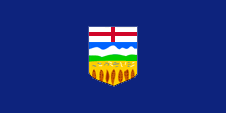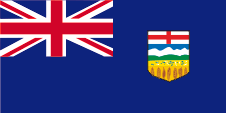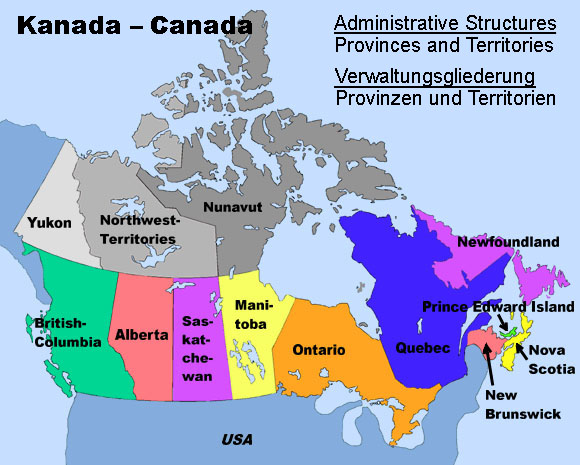mobile View, to the German Version tap the flag


• Flag
• Historical Flag
• Meaning/Origin of the Flag
• Coat of Arms
• Meaning/Origin of the Coat of Arms
• Map
• Numbers and Facts
• History
• Origin of the Country's Name

Flag of the province,
ratio = 1:2,
Source: Corel Draw 4







1907–1968,
Flag flag of the government (state flag),
ratio = 1:2,
Source, by:
World Statesmen




The flag of Alberta was adopet on 1st of June in 1968. It shows by the side's ratio of 2:1 and by the dark blue bunting conspicuously British influences in the designing. In the middle of the flag is placed the blazon of Alberta. Until the year 1922 there had officially been used, the British Union Jack, the so-called Royal Union Flag, by the departments of the provinces, or (from 1922 nearly only) the Canadian blue official flag, the typical British Blue Ensign, with the coat of arms of Canada in the flying end. Nevertheless, the provincial authorities had their own seals and later also coats of arms, which were unauthorized placed in the flying end of the blue official flag. A permit should have been approved by the British authorities for this procedure, this was not the case, but was tolerated. Private individuals had to use the Union Jack and from 1892 the so-called Red Ensign, the red version of the Canadian flag with the Union Jack in the upper corner and the coat of arms of Canada in the flying end. In the course of the gradual separation of Canada from the United Kingdom the Blue Ensign as an official British flag lost its meaning and became replaced by new provincial flags, which may be used by authorities and departments of the provinces and also by private individuals. In this way, Alberta introduced the current flag in 1968. The flag of the province follows British specifications due to history. They are: Blue = Pantone 280, Red = Pantone 186, Yellow = Pantone 116.
Source:
Volker Preuß,
Flaggen Enzyklopädie,
World Statesmen


Escutcheon of Alberta,
Source, by:
Corel Draw 4

There is a regular coat of arms for Alberta, with a console, shield holders (supporters), withe a crest and the motto. Here is only depicted the central part of the coat of arms, the escutcheon. The escutcheon of Alberta shows in the upper part the English Cross of St. George, beneath a scenic depiction with grain ears in the foreground, behind are fields and on the horizon the Rocky Mountains.
Source:
Volker Preuß


Map:
Volker Preuß

Area: 255.240 square miles
Inhabitants: 4.464.170 (2011), thereof 1,6 % native Indians
Density of Population: 17 inh./sq.mi.
Capital: Edmonton, 932.546 inh. (2016)
official Language: English
other Languages: French, German
Currency: Canadian currency
Time Zone: GMT – 7 h
Source:
Wikipedia (D)

1670 · Charles II., King of England, gives large parts of the today's Alberta to the Hudson's Bay Company, in the following years pelt trade with the natives
1795 · foundation of Fort Edmonton
1846 · frontier contract with Oregon, fixing of the southern border on the 49th degree of latitude
1869 · the Hudson's Bay Company cedes all their prerogatives to the British Dominion of Canada
1882 · foundation of the Territory of Alberta, named after Louise Caroline Alberta the fourth daughter of queen Victoria
1890 · discovery of eminent gold findings near Edmonton
1905 · foundation of the Province of Alberta, territorial enlargement in the north by annexion of great parts of the dissolved Territory of Athabaska, Edmonton becomes capital
Source:
Atlas zur Geschichte,
World Statesmen,
Wikipedia (D),
Discovery '97

The province was named after Princess Louise Caroline Alberta (1848–1939), Duchess of Argyll, a member of the British Royal Family. She was the sixth child of Queen Victoria and Prince Albert of Saxony-Coburg and Gotha.
Source:
Wikipedia (D)


![]()









